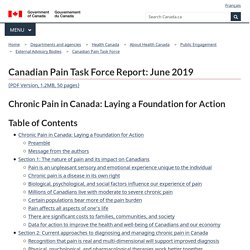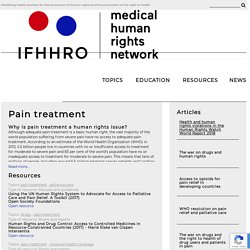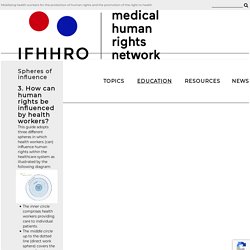

Jull, G. (2017). Biopsychosocial model of disease: 40?years on. Which way is the pendulum swinging? British Journal of Sports Medicine, (16), 1187. Retrieved from. Borrell-Carrió, F., Suchman, A. L., & Epstein, R. M. (2004). The Biopsychosocial Model 25 Years Later: Principles, Practice, and Scientific Inquiry. Annals of Family Medicine, 2(6), 576–582. WCPT. (2017, July 4). How important is the Biopsychosocial Approach when Treating Pain [Video file]. Retrieved from.
Gatchel R., Howard K., Practical Pain Management. (n.d.) The Biopsychosocial Approach,.Retrieved from : Canadian Pain Task Force Report: June 2019. (PDF Version, 1.2MB, 50 pages) Chronic Pain in Canada: Laying a Foundation for Action Table of Contents Chronic Pain in Canada: Laying a Foundation for Action Preamble The Canadian Pain Task Force was established in March 2019 to help the Government of Canada better understand and address the needs of Canadians who live with pain.

In the first phase of their mandate ending June 2019, the Task Force assessed how chronic pain is currently addressed in Canada. Quotations in these boxes throughout the report are responses from twelve Canadians living with chronic pain. This marks only the beginning of the Task Force's engagement of people impacted by pain in their work over the course of their mandate. Message from the authors The creation of the Canadian Pain Task Force marks a formal commitment by the Government of Canada to better understand and address the needs of people living with chronic pain.
Links for Pain. Health is more than healthcare its time for a social ecological approach. Multilevel Analysis in Public Health Research. Big Data in Healthcare: Challenges & Promise. What Is Big Data in Healthcare?

“Big data in healthcare” refers to the abundant health data amassed from numerous sources including electronic health records (EHRs), medical imaging, genomic sequencing, payor records, pharmaceutical research, wearables, and medical devices, to name a few. Three characteristics distinguish it from traditional electronic medical and human health data used for decision-making: It is available in extraordinarily high volume; it moves at high velocity and spans the health industry’s massive digital universe; and, because it derives from many sources, it is highly variable in structure and nature.
This is known as the 3Vs of Big Data. With its diversity in format, type, and context, it is difficult to merge big healthcare data into conventional databases, making it enormously challenging to process, and hard for industry leaders to harness its significant promise to transform the industry. Pain treatment – IFHHRO. Why is pain treatment a human rights issue?

Although adequate pain treatment is a basic human right, the vast majority of the world population suffering from severe pain have no access to adequate pain treatment. According to an estimate of the World Health Organization (WHO) in 2012, 5.5 billion people live in countries with no or insufficient access to treatment for moderate to severe pain and 83 per cent of the world’s population have no or inadequate access to treatment for moderate to severe pain.
This means that tens of millions of people, including around 5.5 million terminal cancer patients and 1 million end-stage AIDS patients, suffer from moderate to severe pain each year without treatment. Little awareness Lack of (access to) adequate pain medication has been a condition in which health professionals have been working for many decades. Paradigm shift One of these reports is “Please do not make us suffer anymore”. Resolution World Medical Association What are the relevant sources? Spheres of influence – IFHHRO. 3.

How can human rights be influenced by health workers? This guide adopts three different spheres in which health workers (can) influence human rights within the healthcare system as illustrated by the following diagram: The inner circle comprises health workers providing care to individual patients.The middle circle up to the dotted line (direct work sphere) covers the areas of work where a health worker is active including colleagues, superiors, patients and their families. The section past the dotted line (indirect work sphere) covers those areas of the work environment in which a health worker is not directly involved. Possible actors in this sphere are hospital management and professional associations.
The primary role of a health worker lies in individual patient care. The inner circle of patient care is, however, not isolated from the outside world. Possible obstacles affecting human rights in patient care include: Work sphere Outside the work sphere. PHCPHFoundationsofUHS MPPJan15.
White, Franklin. (2015). Primary Health Care and Public Health: Foundations of Universal Health Systems. Medical Principles and Practice. 24. 10.1159/000370197. – anmala